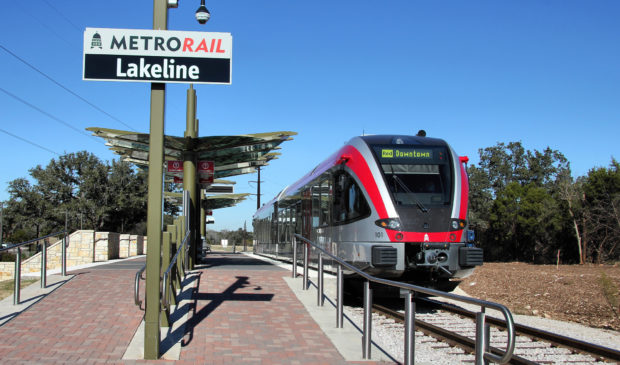Cap Metro: Key to high-capacity transit is dedicated right of way
Monday, September 17, 2018 by
Jack Craver The Capital Metropolitan Transportation Authority is still a few months away from announcing what modes of transportation it plans to propose for Project Connect, the long-term plan to bring high-capacity public transit to the Austin metropolitan area.
Potential solutions include light rail, bus rapid transit, a dramatic expansion of existing MetroRapid bus service, or even autonomous buses.
At a Friday meeting with members of City Council, Capital Metro leaders and transportation consultants stressed that the eventual mode selection doesn’t matter as much as what any effective high-capacity transit depends on: dedicated right of way.
“Whether we’re talking about bus rapid transit, or light rail or autonomous rapid transit, the basic physical infrastructure needs are exactly the same,” said Jeffrey Tumlin, a national transportation consultant who oversaw a series of major transportation and land use changes as interim director of the Oakland Department of Transportation.
“We’re not forced to make a choice (on mode) now,” said Tumlin. “What matters now is: Are we ready to get the right of way?”
Right of way is a persistent challenge for Capital Metro. The main issue is that the agency doesn’t have jurisdiction over the roads its vehicles run on. Those generally belong to the city, the county or the state, whose elected leaders are often reluctant to relinquish right of way, lest the resulting reduction in car lanes anger Austin’s hundreds of thousands of daily motorists.
Ideally, public transit should offer travelers a way to forgo Austin traffic. However, the lack of dedicated right of way means that buses are mired in the same congestion as cars. For instance, the MetroRapid bus lines (Nos. 801 and 803) that travel the Lamar, Guadalupe and South Congress corridors are supposed to come every 10 minutes during peak hours, but they often get stuck in rush-hour traffic, resulting in major delays or “clumping,” where one bus ends up catching up with the bus that is supposed to be traveling 10 minutes ahead of it.
To fundamentally shift the transportation paradigm in Austin, the region needs a system that operates separate from car traffic, providing a mode of travel that offers a large chunk of the population an attractive alternative to driving.
The challenge that regional leaders face is a political one, said Tumlin. They will have to take something away from some people to give to another group of people. What makes it even harder is that those benefiting from the future transit system are not aware of what they’re gaining until the full system is in place several years in the future, while the drivers losing access to car lanes are very much aware of what they’re losing.
However, added Tumlin, “If you want Austin to continue to grow and have a high quality of life, you have no choice.”
Tumlin highlighted Seattle, which in recent years has seen a major decline in car use in favor of public transit as a result of billions of dollars of investment in rail and enhanced bus service. That city took one of its major downtown corridors – Third Avenue – and dedicated it entirely to bus service, running 200 buses an hour on the road. It has similarly reduced car lanes on other major corridors to enhance transit performance.
There are a variety of ways to provide dedicated right of way for transit on an existing major corridor. The most efficient, said Tumlin, are center-running lanes where the transit picks up passengers who board on platforms constructed in the middle of the road, between car lanes. There are also elevated transit lanes, which are more expensive and can prove bothersome to some residents because of the aesthetic impact.
Creating dedicated transit lanes does not necessarily require a major investment or state-of-the-art technology, said Tumlin.
“It’s not that expensive to use paint,” he said.
Acknowledging that taking car lanes away is controversial, Tumlin said that Capital Metro needs to be prepared to deliver frequent service in those lanes as soon as possible. Those sitting in traffic need to see that the lanes they lost are going to use, he said.
Furthermore, the city needs to commit to “unrelenting walkability” in its land use planning and deprioritize car parking. While the city should make the trip to the bus or train stop as safe and easy as possible by building sidewalks, Cap Metro should strive to make the wait as pleasant as possible by providing shade. “You can triple the distance people are willing to walk … if there is something as simple as shade,” he said.
Others speaking on Friday, including Capital Metro President and CEO Randy Clarke and Mayor Steve Adler, emphasized the importance of the multiple government entities in the region working collaboratively on public transit.
Adler said that it was up to current leaders to get working as soon as possible on a transformative system, saying that it was “only going to get harder” as Austin’s mobility and affordability challenges continue to grow.
Photo by Larry D. Moore, CC BY-SA 3.0, Link.
The Austin Monitor’s work is made possible by donations from the community. Though our reporting covers donors from time to time, we are careful to keep business and editorial efforts separate while maintaining transparency. A complete list of donors is available here, and our code of ethics is explained here.
You're a community leader
And we’re honored you look to us for serious, in-depth news. You know a strong community needs local and dedicated watchdog reporting. We’re here for you and that won’t change. Now will you take the powerful next step and support our nonprofit news organization?






